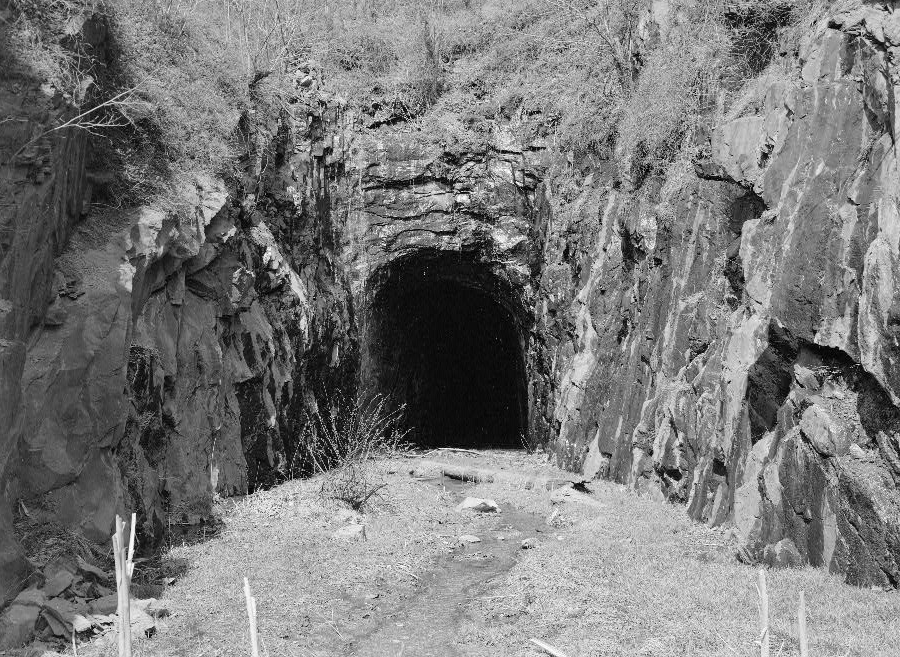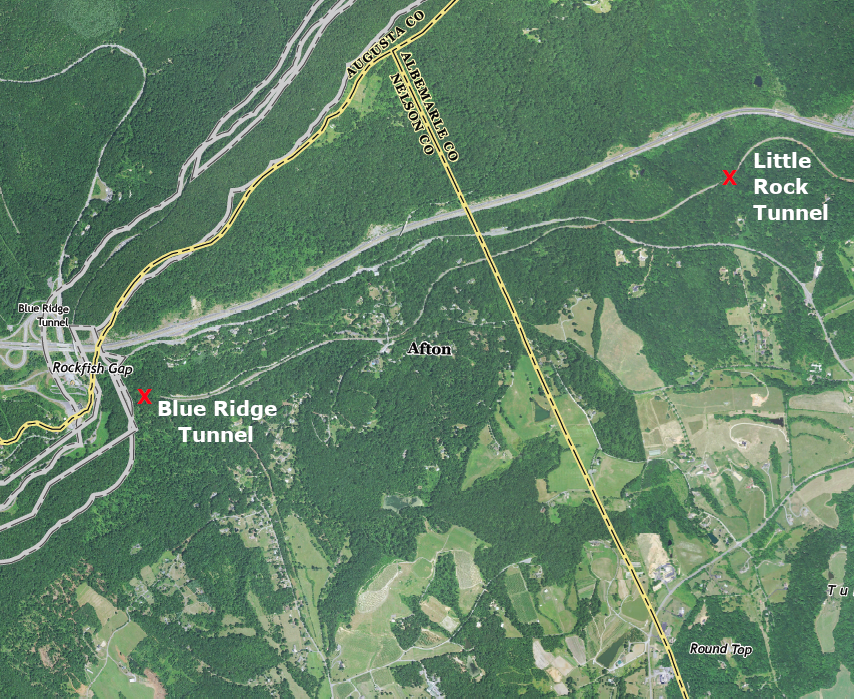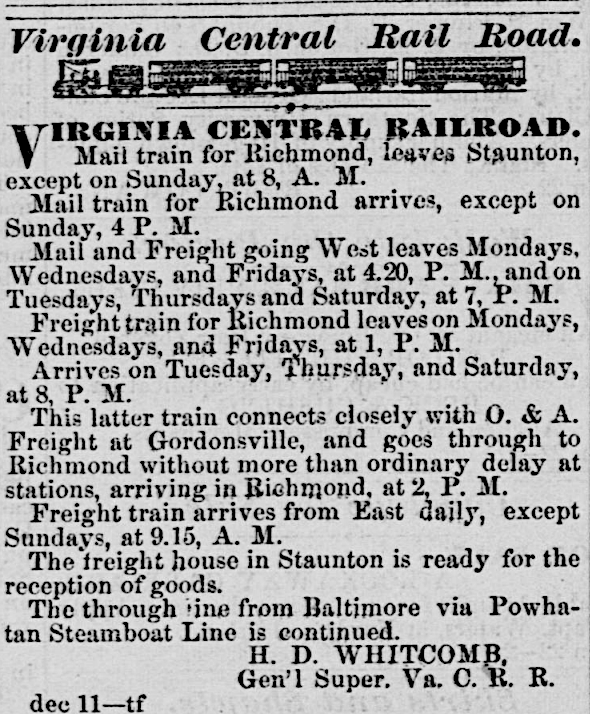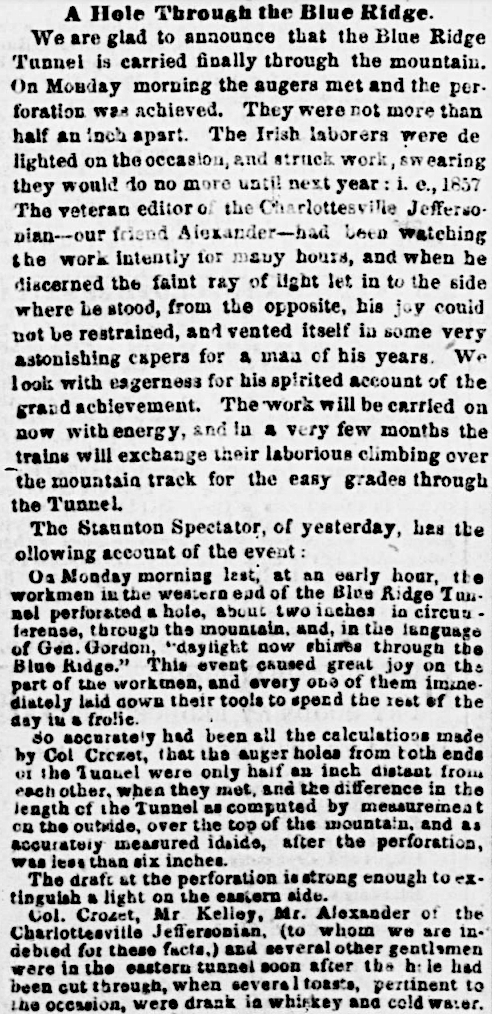
east portal of the Blue Ridge Tunnel, cut through the hard Catoctin Greenstone and opened in 1856
Source: Library of Congress, Blue Ridge Railroad, Blue Ridge Tunnel, U.S. Route 250 at Rockfish Gap, Afton, Nelson County, VA

east portal of the Blue Ridge Tunnel, cut through the hard Catoctin Greenstone and opened in 1856
Source: Library of Congress, Blue Ridge Railroad, Blue Ridge Tunnel, U.S. Route 250 at Rockfish Gap, Afton, Nelson County, VA
In the 1840's, residents west of the Blue Ridge continued to object to the discrimination against them in the General Assembly. The 1830 state constitution guaranteed that the 60% of the members of the State Senate would come from east of the mountains, no matter how much the population grew west of them.
At the same time, funding for "internal improvements" were focused on projects that benefitted the Fall Line port cities. Farmers with high transportation costs in the southern edge of the Shenandoah Valley, with no easy connection to the Winchester and Potomac Railroad or the Chesapeak and Ohio Canal, received minimal state assistance in getting their crops to market. Taxes on western land were funding turnpikes, canals, and railroads east of the Blue Ridge. The Virginia Bureau of Public Works was purchasing 60% of the stock sales that financed those projects, while eastern politicians ensured a low cap on taxes paid by slaveowners for their "property."
At organized conventions, leaders in the western counties agitated for greater equity in public investment to improve transportation networks and thus increase land values west of the Blue Ridge. In 1849 the General Assembly made a major commtment to support a railroad link through the Blue Ridge, and in 1850-51 the state constitution was revised again to address some of the grievances.1

the Little Rock Tunnel built for the Blue Ridge Railroad is still in use, along with a replacement Blue Ridge Tunnel completed in 1944
Source: US Geological Survey (USGS), Waynesboro East, VA 1:24,000 topographic quadrangle (2019)
The Virginia Central had planned to build west of Charlottesville to Covington, but could not obtain the needed funding to construct tunnels through the Blue Ridge just east of Basic City (Waynesboro). The challenge of carving tunnels through the mountains with drills, pickaxes, and black powder was too risky. Costs would be very high and require years in which no revenue would be generated, and it was very possible that all the investment would be lost if tunnels could not be completed.
The General Assembly facilitated a rail connection to Staunton by chartering and funding the Blue Ridge Railroad in 1849, a year before the Louisa Railroad was renamed the Virginia Central. The state absorbed all the risk. The charter authorized the Blue Ridge Railroad to build 17 miles of track from Mechum's River to Basic City on the Shenandoah River. The Blue Ridge Tunnel was the key construction challenge, but three additional tunnels were built as well on the eastern side of the Blue Ridge.
Claudius Crozet led the project. He hired contractors who cleared the right of way, constructed four tunnels, and laid the track. Most workers were Irish immigrants, though enslaved people were also used for several years when the Irish were demanding higher wages.2
Construction started in 1850, starting with the western opening to the Blue Ridge Tunnel on August 1, 1850. Claudius Crozet later identified two start dates for the eastern header, September 28, 1850 and January 1851. The entire Blue Ridge Railroad was finally opened for train traffic in April 1858 when the Blue Ridge Tunnel became operational. Work on the tunnel continued into 1859.
The Blue Ridge Railroad was designed to subsidize closing the gap in the Virginia Central line, enabling the railroad to cut through the mountains. The private corporation, in which the state already owned 40% of the stock, would not have been able to raise the funds required to tackle the tunnel challenge.
Operations on the Blue Ridge Railroad railroad were managed by the Virginia Central. Railroad staff, not state officials, scheduled trains and arranged for fuel and water on the 17 miles of state-owned track. Watchmen lived near the eastern portal of the tunnel, and walked through it daily to check for problems before the daily train arrived.three
The Virginia Central paid tolls to the state for the use of the Blue Ridge Railroad. On April 1, 1870, the railroad (now organized as the Chesapeake and Ohio Railroad) finalized its purchase of the Blue Ridge Railroad. The state received 20,000 shares of C&O stock in exchange. Toll payments to the state ended after the purchase.4

workers digging from the two sides of the Blue Ridge Tunnel finally met on December 29, 1857
Source: Library of Congress, Staunton spectator (January 22, 1867)

workers digging from the two sides of the Blue Ridge Tunnel finally met on December 29, 1857
Source: Library of Congress, The daily dispatch (January 1, 1857)